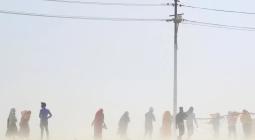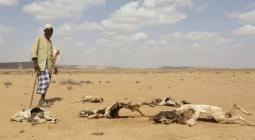Turkish environmentalist highlights El Nino impact on global climate

A Turkish scientist has been conducting research to spotlight the global effects of El Nino, which primarily impacts Central Asia, the Horn of Africa and northeastern Australia
Against the backdrop of a surge in natural disasters worldwide, a Turkish environmentalist has embarked on a research study recently spotlighting the effects of El Nino, a climatic phenomenon notorious for elevating temperatures across the globe and causing a cascade of natural disasters by altering precipitation patterns, air temperatures and wind currents.
Professor Hasan Tatlı, a lecturer in the Department of Geography at Çanakkale 18 Mart University (ÇOMÜ) Faculty of Humanities and Social Sciences, revealed that El Nino, a Spanish term meaning "the son," began to manifest its influence during this year's summer season. This phenomenon, originating in the Pacific Ocean, initially impacts coastal regions before inducing significant climatic shifts on a global scale.
Discussing the ramifications of El Nino, Tatlı told Anadolu Agency (AA) that the polar jet stream winds in the northern United States typically bring precipitation to their effective regions. However, during an El Nino event, these winds veer southward, lose their vigor over previously rain-soaked areas, and ultimately trigger droughts that can lead to devastating forest fires. Tatlı underscored that there is no scientific evidence suggesting El Nino directly affects Türkiye and its surroundings; instead, its primary impact is felt in Central Asia, the Horn of Africa and northeastern Australia.
El Nino not only elevates sea surface temperatures in the eastern Pacific Ocean but also leads to climate change worldwide, Tatlı noted. He explained: "El Nino raises temperatures more than the norm because it reverses the cycle, creating what we call a temperature anomaly. Warming water and increased evaporation in one region do not guarantee precipitation there.
There exists a phenomenon known as horizontal transport, where water vapor capable of generating precipitation can be transported to other regions, leading to rainfall there."
Tatlı emphasized that regions such as Australia and Indonesia, which typically experience rainy seasons, may encounter drought conditions during El Nino periods. He clarified that for precipitation to occur, an upward movement in the atmosphere is required. However, during El Nino events, a counterproductive downward motion occurs, resulting in rainfall deficits. Furthermore, El Nino can stimulate tropical cyclone activity, potentially intensifying hurricane seasons in the Atlantic Ocean.
Under normal climate conditions, trade winds transport warm seawater from South America to Asia, leading to the upwelling of nutrient-rich deep ocean waters. Tatlı cautioned that El Nino can disrupt this delicate balance, causing a loss of nutrients and biodiversity. Rising sea temperatures can also render certain marine organisms unable to withstand the heat, leading to mortality or migration.
Tatlı highlighted the potential impact on aquatic species' feeding habits, noting that some organisms may struggle to access food sources, potentially leading to changes in species diversity. Additionally, he warned that coral reefs, highly sensitive to sea temperature fluctuations, are at risk of dying due to rising temperatures, excessive rainfall or drought. These changes can impact agriculture, resulting in reduced water resources, crop losses and soil erosion.
The urgent need to curb greenhouse gas emissions and climate change management was underscored by Tatlı, who emphasized the importance of reducing fossil fuel usage, transitioning to clean energy sources and enhancing energy efficiency. With drought ranking as the leading natural disaster globally, and earthquakes taking precedence in Türkiye, each region faces unique challenges. Tatlı stressed the importance of establishing early warning systems to monitor and predict El Nino events, allowing communities to prepare for potential impacts such as drought, floods and extreme heat.
PHOTO: DHA





